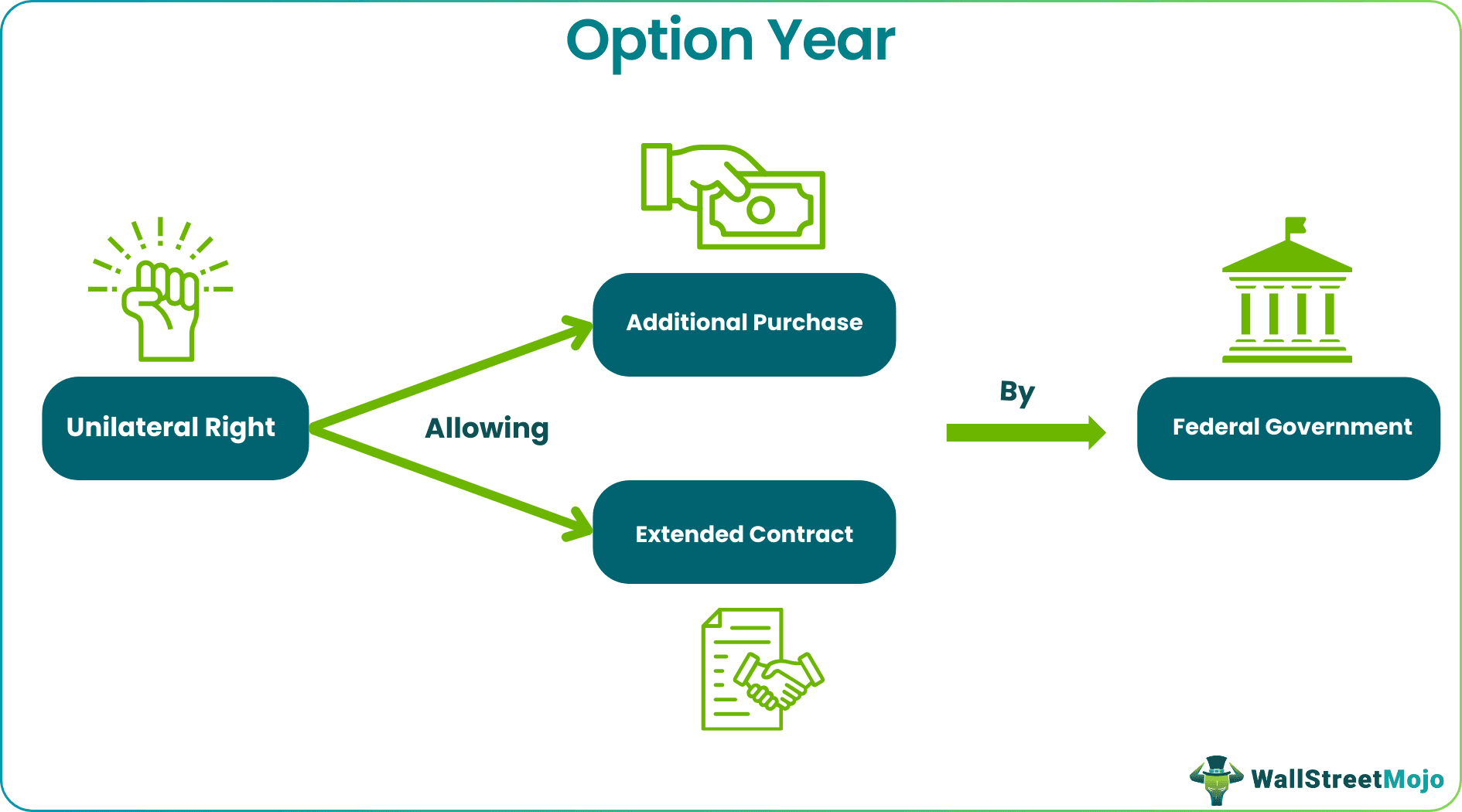Table Of Contents
What Is An Option Year?
An Option Year refers to a one-sided right in a contract, which allows the federal government to either execute a purchase or extend the term of the contract. It serves as a tool to demand ongoing contract performance and is considered the best practice to enable the government to fulfill its necessities, given the other factors plus the price.

By using it, the government may decide to buy additional services or supplies as demanded by the contract. The federal government's contracting officer exercises it if it is felt to be the most advantageous method. It is executed through modification within a contract by giving a written notice to the contract.
Key Takeaways
- An option year is defined as a unilateral contractual facility that allows the federal government to extend the contract's tenure.
- It acts as a vital mechanism for continuous contract performance and fulfilling government requirements effectively by considering factors such as price, compliance, and funding sufficiency.
- It can be exercised by providing written notice, assessing price impacts, ensuring sufficient funds, determining pricing, and ensuring compliance with terms with option clauses cited in official documentation.
Option Year Explained
An option year contract in the US federal government is defined as a unilateral right allowing the state to buy additional services or supplies or extend the contract period to a specific time. It has been included in government contracts to give it the necessary flexibility concerning extending the contract tenure or buying new goods or services. Its exercise is the sole discretion of the government, which must comply with the option terms and necessity under FAR 17.207.
It provides the benefit of meeting ongoing needs for services or goods of the government without initiating an entirely new procurement process. It saves time, workforce, and money in conducting the whole exercise of starting a new tender process. Contractors benefit from it by having continuous work if the federal state decides to invoke the clause in the contract. It also ensures that the current contractor has to keep up its high standards of work to take benefits from the provision. It has been in use in all US federal government service contracts to gain flexibility in fulfilling their continuous needs.
Examples
Let us use a few examples to understand the topic.
Example #1
Let us assume that in an imaginary city of Metroburg in the United States, the federal government engaged contractor Almen for a three-year CCTV system project. The project was ending in Dec 2023, so the government decided to use its power of option year regarding CCTVs. It was decided to either end the CCTV procurement permanently or choose another contractor via a new tender process containing lower prices, higher quality, and favorable terms and conditions to the government.
However, after carefully going through the CCTV market and procuring tenders from many contractors, it was found that Almen had fared better in all aspects. So, the government decided to extend the contract using option year power vested to it under US government contracts.
Example #2
As per an online news article dated June 6, 2023, it has come to the fore that the Marine Corps Facility System Maintenance Contract (MCICOM) has been extended under option year 2. The current contractor, Concurrent Technologies Corp, would continue to manage network systems and facility infrastructure of the U.S. Marine Corps Installations Command per second option year embedded in past awarded contracts. CTC stated that MCICOM has also prolonged the support it provided to the Marine Corps Facility Related Controls Systems program, which covered in excess of 350 networked installation military assets.
CTC does its contractual work in liaison with a small company – Risk Mitigation Consulting, based in Arlington, Virginia. It aims to assist the serviced center in conserving energy, applying cybersecurity practices, and increasing the lifespan of the asset using its program. It also facilitated the training of USMC in safeguarding facilities and various assets.
How To Exercise?
As it is a critical part of a government contract, it needs to be exercised cautiously and in the following manner:
- The contracting office has to provide written notice to the contractor prior to its exercising within a specified time in the contract.
- The contracting officer has to assess the impact on prices of economic price adjustments when a contractor asks for revision before invoking options year.
- The office must ensure sufficient funds and assess different factors like advantageous methods, contractors' past performance and exclusion record, acceptable contract performance, and fulfillment of existing government needs.
- Various option exercises must be determined depending on pricing comparison, market analysis, and the gap between option exercise and contract award.
- The determination process must also include operations continuity, potential costs, and impacts on smaller businesses.
- The contracting officer must make a written determination before exercising the option to ensure adherence to option terms and section 6 requirements and assess the pricing method and option's exercisability.
- Any written document to notify the contractor or contract modification of option exercise has to quote the option clause as an authority.

